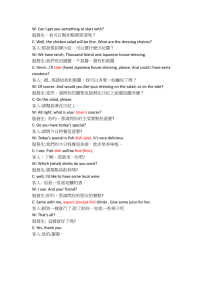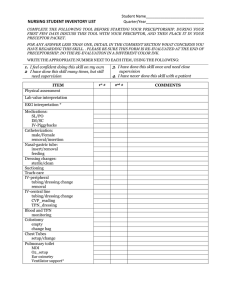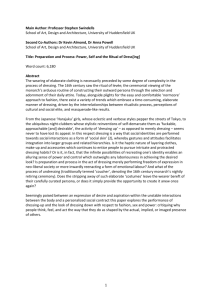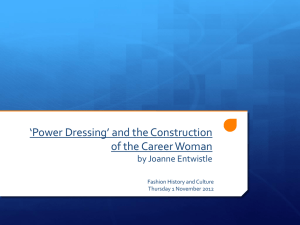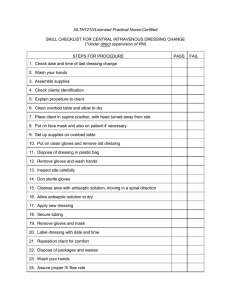Anin-vitro assessment of the effect of intimate contact on bacterial
advertisement
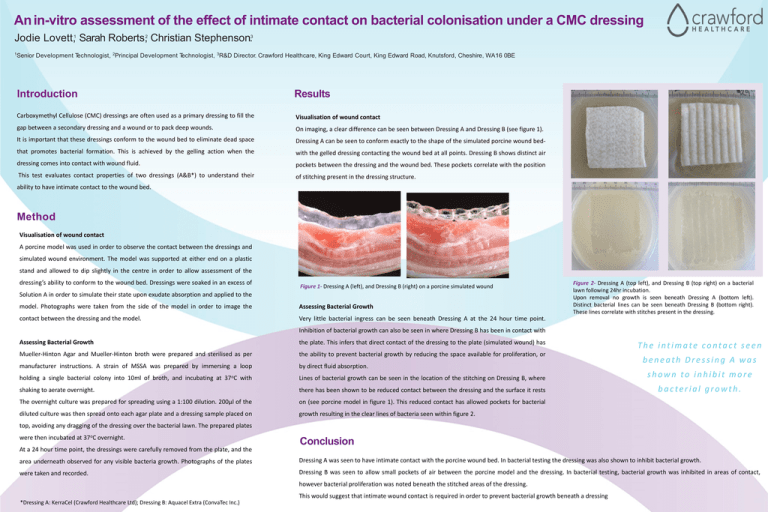
An in-vitro assessment of the effect of intimate contact on bacterial colonisation under a CMC dressing Jodie Lovett,1 Sarah Roberts,2 Christian Stephenson.3 1 Senior Development Technologist, 2Principal Development Technologist, 3R&D Director. Crawford Healthcare, King Edward Court, King Edward Road, Knutsford, Cheshire, WA16 0BE Introduction Results Carboxymethyl Cellulose (CMC) dressings are often used as a primary dressing to fill the Visualisation of wound contact gap between a secondary dressing and a wound or to pack deep wounds. On imaging, a clear difference can be seen between Dressing A and Dressing B (see figure 1). It is important that these dressings conform to the wound bed to eliminate dead space Dressing A can be seen to conform exactly to the shape of the simulated porcine wound bed- that promotes bacterial formation. This is achieved by the gelling action when the with the gelled dressing contacting the wound bed at all points. Dressing B shows distinct air dressing comes into contact with wound fluid. pockets between the dressing and the wound bed. These pockets correlate with the position This test evaluates contact properties of two dressings (A&B*) to understand their of stitching present in the dressing structure. ability to have intimate contact to the wound bed. Method Visualisation of wound contact A porcine model was used in order to observe the contact between the dressings and simulated wound environment. The model was supported at either end on a plastic stand and allowed to dip slightly in the centre in order to allow assessment of the dressing’s ability to conform to the wound bed. Dressings were soaked in an excess of Figure 1- Dressing A (left), and Dressing B (right) on a porcine simulated wound Solution A in order to simulate their state upon exudate absorption and applied to the model. Photographs were taken from the side of the model in order to image the Assessing Bacterial Growth contact between the dressing and the model. Very little bacterial ingress can be seen beneath Dressing A at the 24 hour time point. Figure 2- Dressing A (top left), and Dressing B (top right) on a bacterial lawn following 24hr incubation. Upon removal no growth is seen beneath Dressing A (bottom left). Distinct bacterial lines can be seen beneath Dressing B (bottom right). These lines correlate with stitches present in the dressing. Inhibition of bacterial growth can also be seen in where Dressing B has been in contact with Assessing Bacterial Growth the plate. This infers that direct contact of the dressing to the plate (simulated wound) has Mueller-Hinton Agar and Mueller-Hinton broth were prepared and sterilised as per the ability to prevent bacterial growth by reducing the space available for proliferation, or manufacturer instructions. A strain of MSSA was prepared by immersing a loop by direct fluid absorption. holding a single bacterial colony into 10ml of broth, and incubating at 37oC with Lines of bacterial growth can be seen in the location of the stitching on Dressing B, where shown to inhibit more shaking to aerate overnight. there has been shown to be reduced contact between the dressing and the surface it rests bacterial growth. The overnight culture was prepared for spreading using a 1:100 dilution. 200µl of the on (see porcine model in figure 1). This reduced contact has allowed pockets for bacterial diluted culture was then spread onto each agar plate and a dressing sample placed on growth resulting in the clear lines of bacteria seen within figure 2. The intimate contact seen beneath Dressing A was top, avoiding any dragging of the dressing over the bacterial lawn. The prepared plates were then incubated at 37oC overnight. At a 24 hour time point, the dressings were carefully removed from the plate, and the Conclusion area underneath observed for any visible bacteria growth. Photographs of the plates Dressing A was seen to have intimate contact with the porcine wound bed. In bacterial testing the dressing was also shown to inhibit bacterial growth. were taken and recorded. Dressing B was seen to allow small pockets of air between the porcine model and the dressing. In bacterial testing, bacterial growth was inhibited in areas of contact, however bacterial proliferation was noted beneath the stitched areas of the dressing. This would suggest that intimate wound contact is required in order to prevent bacterial growth beneath a dressing *Dressing A: KerraCel (Crawford Healthcare Ltd); Dressing B: Aquacel Extra (ConvaTec Inc.)


